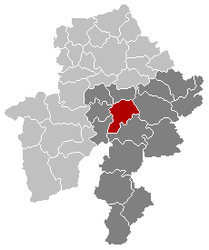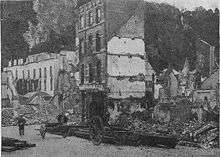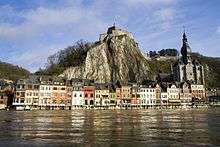Dinant
Dinant (French pronunciation: [di.nɑ̃]) is a Walloon city and municipality located on the River Meuse, in the Belgian province of Namur in the Ardennes. It lies 90 kilometres (56 mi) south-east of Brussels, 30 kilometres (19 mi) south-east of Charleroi and 30 kilometres (19 mi) south of Namur. Dinant is situated 20 kilometres (12 mi) north of the border with France.
Dinant | |
|---|---|
 The citadel, the collegiate church and the Meuse | |
 Flag .svg.png) Coat of arms | |
 Dinant Location in Belgium
Location of Dinant in Namur  | |
| Coordinates: 50°16′N 04°55′E | |
| Country | Belgium |
| Community | French Community |
| Region | Wallonia |
| Province | Namur |
| Arrondissement | Dinant |
| Government | |
| • Mayor | Richard Fournaux (LDB) |
| • Governing party/ies | LDB |
| Area | |
| • Total | 99.80 km2 (38.53 sq mi) |
| Population (2018-01-01)[1] | |
| • Total | 13,544 |
| • Density | 140/km2 (350/sq mi) |
| Postal codes | 5500, 5501, 5502, 5503, 5504 |
| Area codes | 082 |
| Website | www.dinant.be |
The municipality includes the old communes of Anseremme, Bouvignes-sur-Meuse, Dréhance, Falmagne, Falmignoul, Foy-Notre-Dame, Furfooz, Lisogne, Sorinnes, and Thynes.
Geography
Dinant is positioned in the Upper Meuse valley, at a point where the river cuts deeply into the western Condroz plateau. Sited in a steep sided valley, between the rock face and the river. The original settlement had little space in which to grow away from the river, and it therefore expanded into a long, thin town, on a north-south axis, along the river shore. During the 19th century, the former Île des Batteurs (Drummers' Island) to the south was attached directly to the town when a branch of the river was filled in.
Dinant has been enriched by the agricultural opportunities presented by the fertile land on the plateau that overlooks it. Within the town, brassware production is a traditional craft that has benefited from the presence of the broad and, at this point, easily navigable river which has facilitated easy delivery of the raw materials and ready distribution of the resulting products of the artisans' workshops. Another traditional source of wealth is provided by the limestone cliffs overlooking the town, which supported a high-end quarrying industry, producing black marble and bluestone, and whose distribution also benefitted from the proximity of the relatively wide and deep navigable river.
History
Origins to the 10th century
The name Dinant comes from the Celtic Divo-Nanto, meaning "Sacred Valley" or "Divine Valley"; it can also be translated as "Celestial Gorge" or "Luminous Gorge" (as in modern Welsh Nant Dwyfol).
The Dinant area was already populated in Neolithic, Celtic, and Roman times. The first mention of Dinant as a settlement dates from the 7th century, when Saint Perpete, bishop of Tongeren, which at the time had its capital in Maastricht, took Dinant as his residence and founded the church of Saint Vincent. In 870, Charles the Bald gave part of Dinant to be administered by the Count of Namur, the other part by the bishop of Tongeren, which was by that time based in Liège.
In the 11th century, the emperor Henry IV granted several rights over Dinant to the Prince-Bishop of Liège, including market and justice rights. From that time on, the city became one of the 23 ‘‘bonnes villes’’ (or principal cities) of the Prince-Bishopric of Liège. The first stone bridge on the Meuse and major repair to the castle, which had been built earlier, also date from the end of the 11th century. Throughout this period, and until the end of the 18th century, Dinant shared its history with its overlord Liège, sometimes rising in revolt against it, sometimes partaking in its victories and defeats, mostly against the neighbouring County of Namur.
Late Middle Ages
Its strategic location on the Meuse exposed Dinant to battle and pillage, not always by avowed enemies: in 1466, Philip the Good, Duke of Burgundy, uncle of Louis de Bourbon, Prince-Bishop of Liège, and Philip’s son Charles the Bold punished an uprising in Dinant during the Liège Wars, by casting 800 burghers into the Meuse and setting fire to the city. The city's economic rival was Bouvignes, downriver on the opposite shore of the Meuse.
Late Medieval Dinant and Bouvignes specialised in metalwork, producing finely cast and finished objects in a silvery brass alloy, called dinanderie and supplying aquamaniles, candlesticks, patens and other altar furniture throughout the Meuse valley (giving these objects their cautious designation "Mosan"), the Rhineland and beyond.
Henri Pirenne gained his doctorate in 1883 with a thesis on medieval Dinant.
The Old Regime and World War I

In the 16th- and 17th-centuries wars between France and Spain, Dinant suffered destruction, famine and epidemics, despite its neutrality. In 1675, the French army under Marshal François de Créquy occupied the city. Dinant was briefly taken by the Austrians at the end of the 18th century. The whole Bishopric of Liège was ceded to France in 1795. The dinanderies fell out of fashion and the economy of the city now rested on leather tanning and the manufacture of playing cards. The famous couques de Dinant also appeared at that time.
The city suffered devastation again at the beginning of the First World War. On the 15 August 1914, French and German troops fought for the town in the Battle of Dinant, among the wounded was Lieut. Charles de Gaulle. On 23 August, 674 inhabitants were summarily executed by Saxon troops of the German Army — the biggest massacre committed by the Germans in 1914. Within a month, some five thousand Belgian and French civilians were killed by the Germans at numerous similar occasions.[2]
Sights
- The city's landmark is the Collegiate Church of Notre Dame de Dinant. It was rebuilt in Gothic style on its old foundations after falling rocks from the adjacent cliff partially destroyed the former Romanesque style church in 1227. Several stages for a pair of towers on the west end were completed before the project was abandoned in favour of the present central tower with a famous onion dome and facetted multi-staged lantern.
- Above the church rises the vertical flank of the rocher surmounted by the fortified Citadel of Dinant that was first built in the 11th century to control the Meuse valley. The Prince-Bishops of Liège rebuilt and enlarged it in 1530; the French destroyed it in 1703. Its present aspect, with the rock-hewn stairs (408 steps), is due to rebuilding in 1821, during the United Kingdom of the Netherlands phase of Dinant's chequered history. A cable car is available during the high season to take visitors from the Collegiate Church of Notre-Dame to the top of the Citadel.
- Apart from the main block is the Rocher Bayard that was said to have been split by giant hoof of Bayard, the giant horse carrying the four sons of Duke Aymon on their legendary flight from Charlemagne through the Ardennes, told in Les Quatre Fils Aymon, a famous 12th-century chanson de geste. In reality the rock has been divided by the soldiers of Louis XIV after the conquest of Dinant in order to construct a road alongside the river Meuse.
- The house of Adolphe Sax, inventor of the saxophone located in the street of the same name. A little museum, the Mr Sax's House, pays attention to his life and saxophones.
 From the North
From the North- Dinant towards the south, seen from the citadel
 Dinant from Tourist Office
Dinant from Tourist Office_by_Jan_Hillebrand_Wijsmuller_(1855-1925).jpg) Dinant in 1892, by Jan Hillebrand Wijsmuller
Dinant in 1892, by Jan Hillebrand Wijsmuller 2019 Panorama Dinant
2019 Panorama Dinant
Gastronomic culture
- The Flamiche dinantaise is the local version of quiche made with a cheese called "boulette de Romedenne".
- The couque de Dinant is Europe's hardest biscuit, with a honey-sweetened flavour that is impressed with a carved wooden mould before baking.
- The beer brand Leffe originates from Dinant and there is a museum there.
Transport
Dinant's railway station is on the left bank of the river. There is hourly train service to Brussels, about a 90-minute ride.[3]
Healthcare
Dinant hosts the Saint-Vincent and Saint-Anne sites (Centre Hospitalier de Dinant) of the CHU UCLouvain Namur university hospital, the provinces' largest employer and serving as teaching hospital for the University of Louvain.
Born in Dinant
- David of Dinant, philosopher (birth in Dinant is uncertain, 12th century)
- Joachim Patinir or Patenier, 1485–1524, the first specialist landscape painter
- Antoine Joseph Wiertz, painter (19th century)
- Adolphe Sax, inventor of the saxophone (19th century)
- Georges Pire, priest of the Dominican Order and Nobel Peace Prize recipient for 1958
- André-Eugène Pirson (Dinant, 21 March 1817-Brussels, 28 December 1881), governor of the National Bank of Belgium (NBB) from 1877 until 1881
- André Buzin, artist and stamp designer (20th century)
- Alex Miskirtchian, boxer
Twin cities and twinning




See also
References
- "Wettelijke Bevolking per gemeente op 1 januari 2018". Statbel. Retrieved 9 March 2019.
- Horne, John; Kramer, Alan (2001). Conclusion and Perspectives. German Atrocities, 1914: A History of Denial. New Haven: Yale University Press. p. 419. ISBN 0-300-08975-9. Retrieved 8 November 2015 – via books.google.com.au.
... we have confirmed the official wartime estimates that some 6,500 civilians were killed in Belgium and France from August to October 1914.
- "Brussels to Dinant: Train times and train tickets". www.thetrainline-europe.com. Trainline International Ltd. Retrieved 9 November 2015.
External links
| Wikimedia Commons has media related to Dinant. |

- Official web site in French, Dutch, and English
- Dinant groups on Flickr
- Citadel of Dinant: Official web site
- Map of Dinant with localisation of Adolphe Sax House
